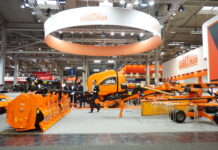For Robert Zulch and son, Fourie what it takes to be the best grower on their farm Wakkerstroom in Ceres’ Witzenberg Valley is the following recipe: Produce the fruit the market wants, in the best quality and in the right size.
In November 2020 Wakkerstroom was awarded a number of trophies by Ceres Fruit Growers (CFG), an owner of Tru-Cape Fruit Marketing, the largest exporter of South African apples and pears, for their success with particular varieties but also the CFG Chairman’s Award for the highest number of total points. By this measure alone Wakkerstroom is producing some of the best fruit in the Ceres valley.
“We all know the Top Red variety as it is on the shelves of every supermarket in South Africa and we mainly grow Top Red for the local market. Our whole focus is to maintain the tree, that is why thinning and pruning is aimed at the next three to five seasons and not only for the next season. We aim for full red in counts that are often used in bag programmes,” Fourie Zulch explains.
The fruit count, the way the apple and pear industry categorises fruit by size, is the number of that size that will fit in a standard carton. So, a count 180 means there will be 180 pieces of fruit in that carton. The smaller the number, the larger the fruit. “For Golden Delicious and Kanzi, the bigger the better”, but Top Red, also known as Early Red One, we aim for smaller,” he says. Wakkerstroom won the CFG award for producing the best Early Red One.
“For every variety we try to maintain the optimal fruit mass for the size count we want,” Zulch says adding: “We can’t be those people out there hunting for tons. We want to grow the optimal Class One fruit. We don’t load the tree so we achieve the right quality and the right fruit size. It is all about balance. We try to take out marginal fruit during thinning and we are very strict with our pickers and sorters not to bruise fruit while sorting,” he says. According to Zulch, Wakkerstroom has used almost the same team of seasonal workers every year and “we aim to employ them full-time on Wakkerstroom.”
“It means a lot to us to have a team of staff who understand us and appreciate what we are trying to achieve. Our pickers take out hail or sun-damaged fruit as soon as they see it and this goes directly to the juice plant reducing the risk of bruising the quality fruit in the CFG bin,” he says.
Wakkerstroom also won an award for producing the best Kanzi apples. “The aim is for the maximin Class One tonnage from the start and everything is handled that way. As Kanzi has a short stem we try to thin to singles per bunch which gives better sun coverage for the bi-coloured fruit and less chance of stem-end punctures,” he says.
Although Wakkerstroom also won a trophy for the best Mahana Red, Fourie Zulch says it is a very easy apple to grow. “We just plant Mahana Red and forget about it. We do struggle to get the right size we want though they tend to grow big. We want fruit sized around 59mm. Our Mahana Red trees are about 13 years old and a little younger than the norm. We are loading the trees to produce about 110 to 120 tons a year just to get the right size of Mahana Red. There is a challenge for some staff to understand that for Mahana Red we want small-sized apples whereas for most of the others the axion ‘big is best’ is true.”
Fourie Zulch explains that Rosy Glow is the variety which is replacing the older Cripps Pink variety to produce the Pink Lady® apple. Wakkerstroom won the trophy for producing the better Rosy Glow apples in the region. “We had old Cripps Pink that coloured poorly but since we started growing Rosy Glow we find that the site in the valley suits this variety very well. We are producing about 100 tons every year with a high packout of Pink Lady®.”
Looking at the spread of awards which cover both apple and pear varieties, Wakkerstroom’s success is mainly in growing apples. “When I came to the farm in 2007 we had 100 hectares of fruit and it was split 40% pears and 60% apples. Now the spread is 91% apples. “And,” Zulch continues, “in the next three years we are taking out even more pears and only keeping Abate Fetel, Forelle and Packham’s Triumph.”
Every grower wants to win the award for the highest income per hectare. In 2020, this award, for the highest income per hectare of apples, went to Wakkerstroom. “I think our staff plays an important role here and we have performance bonuses in place,” Zulch says, “our secret is not a secret at all. We focus on growing Class One fruit.”
Recent investments include drone technology from Aerobotics to map the farm and using software that highlights stressed spots because of dryness or insects like red-spider mite or areas that need fertigation and they are using probes to accurately measure soil moisture and transpiration.
“By 2024, 80% of Wakkerstroom will be orchards younger than 18 years. We are replacing marginal orchards with varieties that produce better colour and quality for example we are replacing Braeburn with Mahana Reds.” Zulch ends.
Tru-Cape Fruit Marketing’s managing director, Roelf Pienaar says Wakkerstroom must be congratulated on this success. “But, more important than these recent awards is the deep and long relationship that Tru-Cape has with the Zulch family. We co-own the rights to the Fuji Royal variety with Robert Zulch,” he ends.









